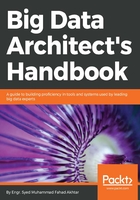
Variety
In this section, we study the classification of data. It can be structured or unstructured data. Structured data is preferred for information that has a predefined schema or that has a data model with predefined columns, data types, and so on, whereas unstructured data doesn't have any of these characteristics. These include a long list of data such, as documents, emails, social media text messages, videos, still images, audio, graphs, the output from all types of machine-generated data from sensors, devices, RFID tags, machine logs, and cell phone GPS signals, and more. We will learn more details about structured and unstructured data in separate chapters in this book:

Variety of data
Let's take an example; 30 billion pieces of content are shared on Facebook each month. 400 million Tweets are sent per day. 4 billion hours of videos are watched on YouTube every month. These are all examples of unstructured data being generated that needs to be processed, either for a better user experience or to generate revenue for the companies itself.
The fourth characteristic of big data is veracity. It's time to find out all about it.